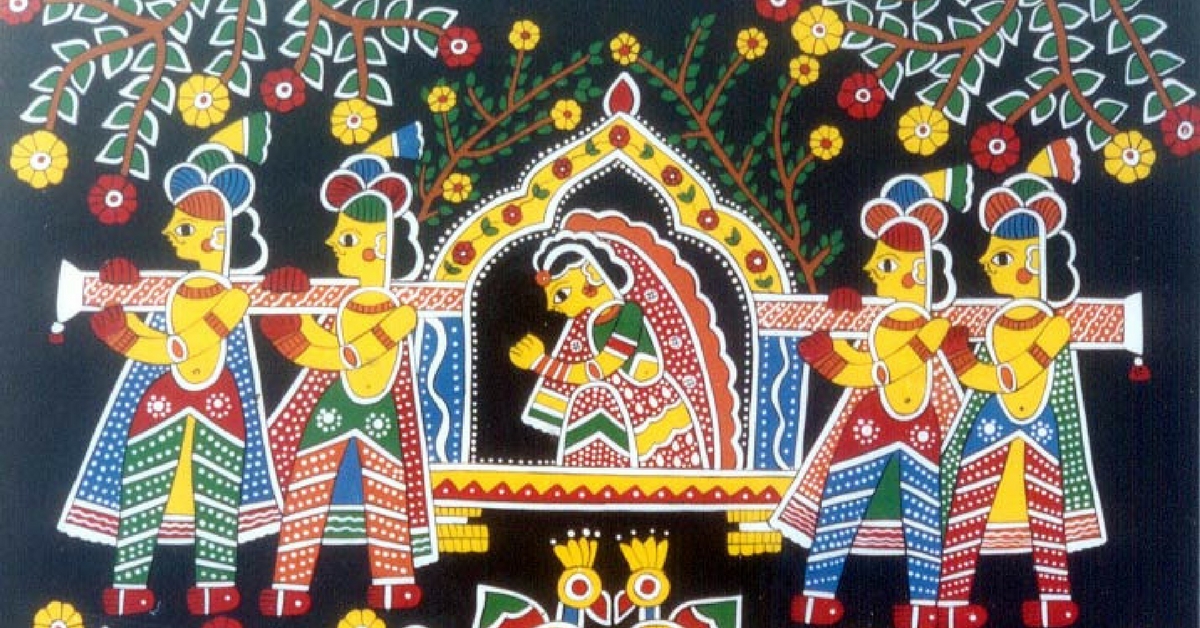TBI Blogs: An 800-Year-Old Art Form Is Helping over 300 Women in Bihar Earn Livelihoods
India’s multiple indigenous art forms are more than just windows into the country’s rich culture and history. Often, they are also important sources of livelihood and empowerment for their artisans. One such art form from Bihar is Tikuli art, empowering the state’s women artisans.

India’s multiple indigenous art forms are more than just windows into the country’s rich culture and history. Often, they are also important sources of livelihood and empowerment for their artisans. One such art form from Bihar is Tikuli art, empowering the state’s women artisans.
Tikuli art is an unique art form from Bihar, which has a very rich and deep traditional history. The word ‘tikuli’ is the local term for ‘bindi’, which is usually a bright, colourful dot that women wear between their brows. In the past, the bindi was created as a symbolic means of worshipping intellect and conserving the modesty of women. However, in today’s time, Tikuli art serves as a source of empowerment for the women of Bihar.

Tikuli art originated in Patna over 800 years ago. It deals with beautifully designed paintings which are manufactured in the local streets of the city. With flourishing sales, the tikuli art-form managed to influence traders from across the country to flock to Patna to buy Tikuli art in bulk. The Mughals were active patrons of the art form, and appreciated its many salient features.
This is a rare specialty of Bihar, and no such work is found elsewhere. Since it is very intricate and detailed, it requires a special set of skills. Tikuli art is expensive too, as the value of the art is directly proportional to the refinement of the work.
In the picture below, it can be easily seen that even though the figures are small in scale, the artist has not compromised on the details.

With the decline of the Mughal Empire, and the coming of the British Raj, Tikuli art faced a severe blow. The British introduced industrialization, and indigenous goods came to be replaced by cheap machine-made goods. Thousands of Tikuli artists were left jobless as machine-made bindis came into the market, and Tikuli art was lost in the chaos.
The revival of this art form can solely be attributed to two artists. In 1954, Chitracharya Padmashree Upendra Maharathi single-handedly took on the initiative of reviving this dying art form.
He got the idea of portraying Tikuli art on glazed hardboard during his stay in Japan, where artists were commercially selling traditional motifs on colorful hardboard.

Artist, craftsman, and painter Shree Ashok Kumar Biswas took Tikuli art to a whole new level. He, along with his wife Shibani Biswas, revived the art and developed it into a source of livelihood. Tikuli art now serves as an economic beneficiary for over 300 women in Bihar. The noble efforts of the Biswases and the workmanship of these women are nationally and internationally acclaimed. In 2012, Ashok was selected to participate in the Bihar Divas Celebrations organized in Delhi and Jaipur. He also explained the subtle art of Tikuli to the visitors of the International Fair held in Seoul.

Making Tikuli art is a delicate and tedious process. Simply put, one can divide it into three steps:
- Tikuli artists use hardboard to create paintings. They cut the hardboard into various shapes like circular, rectangular, triangular, or square.
- The artists apply 4-5 coats of enamel thereafter on the cut wooden piece. After every coat, they rub the wood with sandpaper, thus giving it a polished surface.
- After the final coat of enamel, the artisans paint the design. It is also embellished with gold foil and jewels.
Tikuli art also uses Madhubani motifs in its paintings.
It exemplifies the art, and it is always a wonderful feeling to see two exceptionally brilliant art forms together in one frame.

Spring and summer are the most suitable for making this art, as the craft requires dry air at room temperature due to usage of enamel paints. The artists use squirrel or sable hair to make the brushes, and the size range varies from 0.0-20.
Tikuli art, as a product, is more popular as an export, rather than as something of cultural significance. The aim of the products is to showcase Indian culture to the rest of the world. The themes mostly revolve around festivals of Bihar, Indian wedding scenes, and Krishna Leela.

(Content Research and Conceptualisation by Kaavya Laxman. Content written by Kaavya Laxman and Saumya Sinha.)
Originally published on Nazariya. If you know any artists Nazariya can work with, please send in the details on email.
Like this story? Or have something to share? Write to us: [email protected], or connect with us on Facebook and Twitter.
NEW: Click here to get positive news on WhatsApp!
If you found our stories insightful, informative, or even just enjoyable, we invite you to consider making a voluntary payment to support the work we do at The Better India. Your contribution helps us continue producing quality content that educates, inspires, and drives positive change.
Choose one of the payment options below for your contribution-
By paying for the stories you value, you directly contribute to sustaining our efforts focused on making a difference in the world. Together, let’s ensure that impactful stories continue to be told and shared, enriching lives and communities alike.
Thank you for your support. Here are some frequently asked questions you might find helpful to know why you are contributing?


This story made me
-
97
-
121
-
89
-
167











